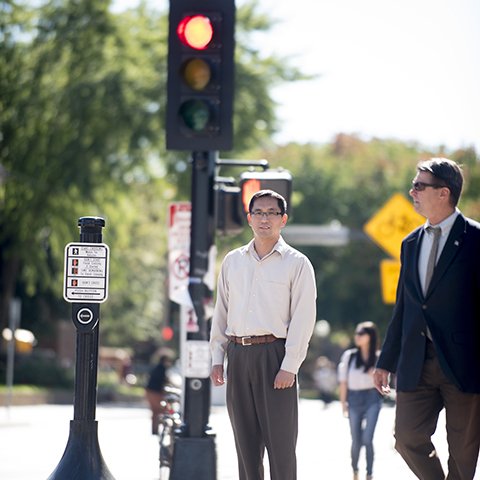Chen-Fu Liao: Safer crossings

Written by Eve Daniels
Today, more than 20 million Americans are visually impaired, and more than 80,000 of them live in Minnesota. That’s just the people who reported vision loss, as many are reluctant to identify themselves. By 2030, the numbers are expected to double nationwide.
If we don’t have vision loss, it’s easy to take our sight for granted. But for the visually impaired, who rely on walking and public transit to get around, everyday tasks like crossing the street present a lot of challenges.
Current pedestrian signal systems aren’t the answer. There’s no standard location for push-button audio signals, so visually impaired pedestrians must deviate from their path to request a signal, making it even harder to navigate. And not all intersections are equipped with this technology, which, incidentally, costs a lot to maintain.
Fortunately, Chen-Fu Liao, Center for Transportation Studies researcher, has developed a solution. It’s called the Mobile Accessible Pedestrian Signal (MAPS) system, and it provides signal and intersection geometry information at signalized intersections via a smartphone app.
“You use a single tap to survey the environment and find out street names, direction and other information, and a double tap to confirm the crossing direction and request a walk signal,” Liao said.
The app wirelessly requests signal timing and phasing information from the traffic signal controller. Along with auditory cues, the phone vibrates when the walk sign is on, and again when time is running out. In the early stages of development, Liao interviewed 10 visually impaired Minnesotans to find out what kind of app they would find most useful. Based on the survey feedback, he came up with a simple yet effective interface. It won’t replace or interfere with the white cane, but rather serve as a supplement.
MAPS has already been field-tested at intersections in Minneapolis and Golden Valley, Minn., with promising results. Now, Liao is working with central traffic control vendors to implement the system in a 10 by 10 block area near the Vision Loss Resources centers in Minneapolis or St. Paul. Eventually, the system will incorporate bus stops and work zones using a Bluetooth low energy module.
It may also expand to subways. Recently, Liao presented the system to the New York City DOT and they expressed serious interest. “They’re watching the progress in Minneapolis to make their decision,” he said.
Beyond his research and testing, Liao learns a lot from casual conversations. Every other Monday, he volunteers as part of a walking group for Vision Loss Resources clients. “We walk around in the mall and the clients discuss what’s happening in their lives,” he said. “Through this process, I see the need, and I’ve developed a love for the work.”
